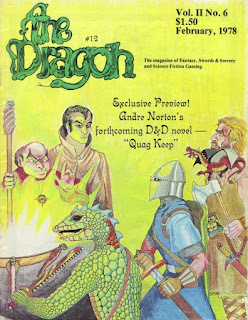The Articles of Dragon: "The Lovecraftian Mythos in Dungeons & Dragons"
 In honor of The Shadow over August, I thought I'd do something a little different with my weekly "The Articles of Dragon" series. Instead of continuing to highlight articles that I remember or that made a strong impression on me – good or bad – from my youth, I'm instead going to spend this month focusing on Dragon articles that touch upon H.P. Lovecraft, his Cthulhu Mythos, or related topics. Interestingly, nearly all these articles come from before I was even involved in the hobby, let alone reading Dragon regularly. While I can't say for certain why that might be, I have a theory that I'll discuss later in this post.
In honor of The Shadow over August, I thought I'd do something a little different with my weekly "The Articles of Dragon" series. Instead of continuing to highlight articles that I remember or that made a strong impression on me – good or bad – from my youth, I'm instead going to spend this month focusing on Dragon articles that touch upon H.P. Lovecraft, his Cthulhu Mythos, or related topics. Interestingly, nearly all these articles come from before I was even involved in the hobby, let alone reading Dragon regularly. While I can't say for certain why that might be, I have a theory that I'll discuss later in this post.
The "From the Sorcerer's Scroll" column is nowadays associated with Gary Gygax, but its first three appearances (starting with issue #11 in December 1977) were penned by Rob Kuntz. Furthermore, the second of these initial columns, entitled "The Lovecraftian Mythos in Dungeons & Dragons," is, in fact, largely the work of J. Eric Holmes with additions by Kuntz. In his brief introduction to the article, Kuntz explains that the material is intended to be "compatible with Dungeons & Dragons Supplement IV 'Gods, Demigods & Heroes'." It's also meant to satisfy both "Lovecraft enthusiasts" and those "not familiar with the Cthulhu cycle."
From the beginning, it's immediately clear that, despite its title, much of what follows in the article is not authentically Lovecraftian but owes more to August Derleth's idiosyncratic interpretation of HPL's work. For example:
The Great Old Ones of the Cthulhu Mythos are completely evil and often times chaotic. They were banished or sealed away by the Elder Gods.Now is not the time to relitigate the case of Lovecraft v. Derleth, which is a much more complex and nuanced discussion than many people, myself included, have often made it out to be. However, I bring this up simply to provide context for what follows. In February 1978, when issue #12 of Dragon appeared, Lovecraft scholarship was, much like that of Robert E. Howard, still in very much in its infancy, with the popular conceptions of both writers and their literary output still very much in the thrall of pasticheurs like Derleth, L. Sprague de Camp, Lin Carter, etc. With that in mind, we can look at the article itself.Holmes describes "only Lovecraft's major gods," namely, Azathoth, Cthulhu, Hastur, Nyarlathotep, Shub-Niggurath, Cthugha, Ithaqua, Yig, and Yog-Sothoth. These selections clearly show the influence of Derleth, who was very keen on Hastur, Ithaqua, and Cthugha, the last two of which were his own inventions. Each god is given an armor class, move, and hit points, along with magic, fighter, and psionic ability. I find these statistics really fascinating, as they're somewhat unimpressive by the standards of later editions of D&D, but were considered exceptionally powerful by the standards of OD&D, for which they were written. Cthulhu, for example, has only AC 2 and 200hp and fights like a 15th-level fighter.
Also described in the article are Byakhee, Deep Ones, the Great Race, the Old Ones, Mi-Go, and Shaggoths [sic]. They're described in the same way as the gods, using the same game statsistics. What I found interesting here is that Holmes suggests the Byakhee are more potent opponents than the Shoggoths, something my post-Call of Cthulhu brain wouldn't have concluded. From the vantage point of the present, that's what makes this article so fascinating: it's an artifact from a time before Chaosium's RPG was published and helped to popularize not just Lovecraft's creations but a particular interpretation of them. This article is an alternate presentation of those creations and, even if I disagree with parts of it, I appreciate its uniqueness.
Obviously, this article was published before 1980's Deities & Demigods, whose early printings included a different presentation of the Cthulhu Mythos. As a kid, my copy of the book was one of the later printings that didn't include this chapter (or that of Moorcock's Melnibonéan Mythos) and indeed I didn't even notice its absence until I was in college. My roommate has a copy of one of the early printings and I was flabbergasted when I saw its extra chapters. The saga of the inclusion and removal of the Cthulhu and Melnibonéan material from the DDG is well known, I think, so I won't repeat it here. However, I wonder if it left a sufficiently bad taste in TSR's mouth that Dragon would thereafter include almost no Lovecraft-related material in its pages for years after the event.
James Maliszewski's Blog
- James Maliszewski's profile
- 3 followers



